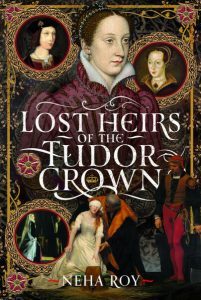Historian Valerie Schutte is the author and editor of several books about Tudor Queens, including: ‘Mary I and the Art of Book Dedications: Royal Women, Power, and Persuasion’, ‘Unexpected Heirs in Early Modern Europe: Potential Kings and Queens’, ‘Princesses Mary and Elizabeth Tudor and the Gift Book Exchange.’
Her latest book, ‘Mid-Tudor Queenship and Memory: The Making and Re-making of Lady Jane Grey and Mary I’ co-edited with Jessica S Hower was published in September 2023.
Buy ‘Mid-Tudor Queenship and Memory: The Making and Re-making of Lady Jane Grey and Mary I’:
Follow Valerie Schutte on Social Media
Valerie’s website: Valerie Schutte
Twitter: @TudorQueenship
Many thanks to Valerie for answering my questions.
How was this particular focus on Mary and Jane decided on?
I actually envisioned this collection initially to only be about Mary I’s accession. When I sent out the original call for papers, it was for a volume that would rethink Mary’s accession and first few months as queen. However, when I started to receive proposals, many were on Jane or on Mary and Jane together. It quickly became clear that Mary’s accession could not be separated out from Jane’s similar experience in July 1553. The two women were cousins who became rivals.
What does the book add to previous works covering these women?
There has been some really excellent work on both of these women, but nothing previously has only focused on Mary, Jane, July 1553, and how that has been understood over the last 500 years. As much as the succession crisis of July 1553 involved both women being pitted as rivals, this has continued in their respective historiographies. This book provides a greater understanding of how these women affect the reputations of each other.
What surprised you most editing this book?
What I love about all of these essays is that they take familiar topics, such as Wyatt’s Rebellion or historical fiction featuring these women, and rethinks them in new ways. The earlier chapter in the volume show ways in which Mary and Jane used history, literature, and music to legitimize their reigns, while the later chapters cover posthumous depictions of the queens on page and stage. I think I was most surprised by how you cannot get a full story of the accession of Mary I without considering the place and influence of Jane. I was also really interested in how Mary and Jane have been portrayed as rivals, when they were actually close cousins before the events of July 1553.
Your chapter looks at representations of Edward Underhill. Why did you choose this focus?
Edward Underhill is a fascinating man, and I was thrilled to find a nineteenth-century gothic horror novel that featured him as a main character. I came across his memoir while looking for sources of ballads that were written for Mary’s accession. Once I started to read more about him, The Tower of London novel popped up as a fictional account of him. Frequently, as my essay shows, the fictional Underhill was portrayed as more radical than the historical Underhill. But the novel was very important and influential in its account of the layout of the Tower, providing a moderate account of Mary as queen, and portraying Jane as a level-headed martyr, unlike the power-hungry men around her.
Did you learn anything new about Jane editing these essays?
I did! I think the basic facts of Jane’s life are well-known. It also seems as though much previous work on Jane is hagiographical, in that she is seen as a flawless martyr, one of the most high-profile victims of Mary’s burnings. In reality, their lives and relationships were more complicated. In editing this collection, I learned the importance of humanizing both of these women together. I also learned that Jane faced so many outside pressures to be named as queen. After her death, Jane was really used as an example of moral, pious living. And both during and after her lifetime, she remains under pressure to be a perfect Protestant martyr and candidate for the throne.






































